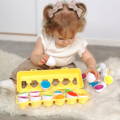What are Montessori Toys?
Montessori toys are toys inspired by the Montessori method that encourage children to learn independently through a trial-and-error approach. They stimulate kids to experiment and find their own solutions, but most importantly, children have an active role during their playtime rather than passively watching what a toy can do on its own.
This way, children test their problem-solving skills, put their imagination to use, and work on their fine motor skills, among other things. Developing skills requires using said skills, and that’s exactly what Montessori toys invite children to do.

However, the term “Montessori” comes from Maria Montessori and the teaching method named after her. She was one of the first Italian female physicians and a school teacher in the late 19th and first half of the 20th century. In 1907, she opened the first Montessori school for underprivileged children in Rome.
This is where she perfected her teaching method, seeing how students can learn from their surroundings, their peers, and, ultimately, themselves.
She discovered that her pupils needed merely guidance and not constant hands-on supervision. She found out that independence is one of the most important characteristics teachers should nurture in their students. Modern Montessori toys follow the same principle.
What Is the Difference Between Montessori Toys and Regular Toys?
A toy doesn’t have to have “Montessori” written all over it to do everything a Montessori toy should. Simple building blocks you can find in the kids' department in your local mall can act as a Montessori toy.
However, there are a few features you should look out for when purchasing toys if you wish to buy those that follow the Montessori method. Here are some of them:
No Batteries, No Flashing Lights, No Automated Sounds:
First and foremost, batteries present a huge danger to children’s health. Kids are curious, and even though we hate seeing it, they put stuff up their noses and mouths. It might seem strange, but that’s one way how they explore the world around them.
Now, when that “stuff” is a battery, it becomes a serious matter. Button cell batteries are common in modern toys. They are really small and can get easily swallowed, but the worst thing is they contain lithium which is poisonous. This is one of the reasons Montessori toy designers opted out of using them - creating non-toxic baby toys is a top priority for conscious manufacturers.
The other main reason is their effect on children’s development. Battery-powered toys, more often than not, have flashing lights and/or make loud noises. They’ll occupy a child’s attention, but they can easily cause overstimulation which results in anxiousness, irritability, and stress. They leave no room for either imagination or problem-solving.
Take Montessori Geometric Eggs, for example. On the surface, they seem simple. What they do, however, is much more complex. By incorporating them in their playtime sessions, kids learn geometry, practice sorting and matching, work on their fine motor skills, learn colors, and so much more.

They're Based on Real-Life Objects and Beings
During her teaching years, Maria Montessori observed two things about children up to age 6. First, they can’t understand the difference between what’s real and what’s make-believe. Kids don’t question things they see, they just accept them.
This creates a lot of confusion in young minds. That’s why the followers of the Montessori approach prefer telling stories about reality-based stuff like actual animals instead of dragons to young children.
The second thing Dr. Montessori observed is the fact that children under 6 actually prefer real stuff to fantasy. It’s tangible and, therefore, easier to comprehend. Children are fascinated by the real world and should be allowed to explore as much as they want to as long as they’re in a safe environment.
However, do not mistake the lack of fantasy in the Montessori teaching method for the lack of imagination.
Fantasy is ideas and stories that do not exist in our world (fairies, superheroes, monsters, etc.). Imagination, on the other hand, is the ability to envision scenarios, images, or ideas based on the stuff you already know. It’s creating something new, like music, drawing a picture, or inventing a game.
There is a place for fantasy once children get a bit older. However, the development of kids’ imagination during their early years is encouraged through real-life stories and experiences. A Montessori toy that ticks all these boxes is the Montessori Story Book.
They Focus on One Skill at a Time
The Montessori method, and consequently the Montessori toys, are all about mastering one skill at a time. That’s why there shouldn’t be more than a few toys in a child’s playtime rotation.
Also, a single toy shouldn’t challenge a child to complete multiple tasks at the same time. If a toy has too many options, or if there are too many toys available, they become a distraction. Attention span is built by focusing on one thing before the other.
A great way to develop multiple skills simultaneously, like fine motor, hand-eye coordination, and attention span, but only by focusing on a single task is the Montessori Magnetic Maze.
They Promote Independent Play
There are three aspects of independent play that the Montessori method and toys encourage:
- Kids should choose what they play with and what they learn. This is the approach that Maria Montessori stood for from the very beginning. Following up on their built-in interests will see them develop their skills to their full potential. Therefore, if you’re choosing between toys you think are of the same quality and educational value, let your kid decide which one they like the most.
- Children should be able to complete their tasks and play with their toys on their own. This doesn’t mean they shouldn’t play with other kids. Absolutely not! This just means that every challenge they are faced with (a puzzle, for example) should be achievable by themselves. They shouldn’t need any help from adults. However, those toys still need to be complex enough so that they maintain a child’s interest.
- Montessori playtime results in more independent children - children who can get dressed on their own, tie their shoes, pack their own lunch, and even prepare a meal for themselves. A toy that can kickstart these habits in your home is the Montessori Busy Board.
They are Open-Ended
These types of toys have no set goals. They can’t be “completed” or “finished” by playing with them once or twice. The idea is to let a child imagine and create their own playtime scenarios around them. This is how we nurture creativity in children. Perfect examples of these toys are the Montessori Wooden Stones and the Montessori Magnetic Set.
However, there are some close-ended toys that are at the core of the Montessori philosophy. Maybe the most recognizable ones are puzzles. And there is nothing wrong with close-ended toys.
They have an exact purpose. A child plays until they reach a specific goal. This creates a sense of commitment and, finally, accomplishment.
One thing to consider when it comes to close-ended toys, though, is their complexity. If they are not designed so the child finds them a challenge or too difficult, on the other hand, they serve no purpose.
Are Montessori Toys Always Wooden?
No, they are not. Other popular material choices are fabrics like wool or felt. They can also be ceramic or metal. The idea Maria Montessori had was to introduce children to materials that can be found in everyday objects. Material variations are a great way to teach kids about different textures and weights.
However, the most common material in Montessori toys is, indeed, wood. It’s safe, natural, and eco-friendly. Wooden toys aren’t overwhelming, too bright, or too loud. They can endure for years and years, making them perfect to pass on to younger siblings.
But…

Does Montessori Mean No Plastic?
It does not. One thing to remember is the period when Maria Montessori worked and did her research in child education and psychology. Plastic toys began being mass-produced only after WW2. Dr. Montessori was already in her late 70s at that time. Simply put, they weren’t common when she created her teaching method.
Make no mistake, toys made from natural materials bring more benefits than plastic ones, but that doesn’t mean plastic toys are bad. In these modern times, plastic is all around us. We should aim to reduce its usage, but plastic can also be recycled to a certain extent.
If you have a plastic Montessori toy with all characteristics mentioned above, don’t fret. That toy is perfect. And more often than not, plastic toys are more available than wooden ones.
Montessori toys are the best choice for kids in this age of done-for-you way of living. Everything is just a tap-on-screen away from you. That kind of upbringing is definitely not optimal.
That’s why Montessori toys are made to challenge children to think, adapt, and use both their physical and mental muscles, but not to be frustrating. To find the perfect one for your child, you should pick Montessori toys by age.
If you have any further questions, feel free to contact us at info@montessorigeneration.com.
Free Delivery
Over $80
Easy Returns
No questions asked
Unbeatable Warranty
1-year ++ warranty
- Secure CheckoutWorld’s most secure payment method




